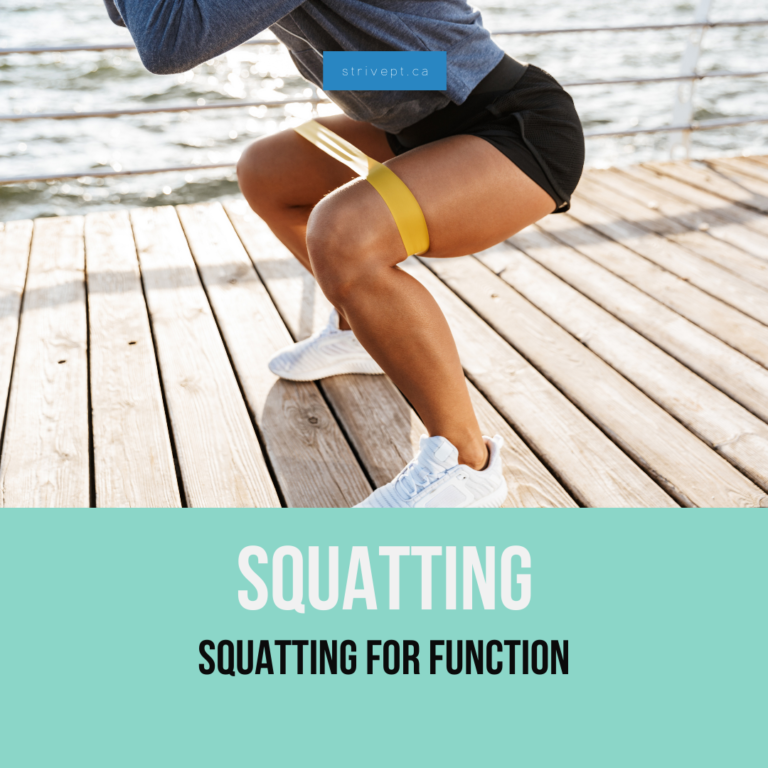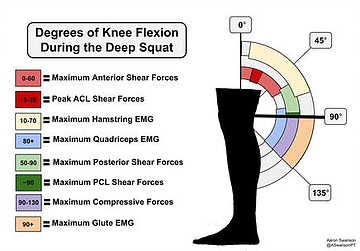
Squatting is one of the most, if not the most functional movement in human life.
Getting on/off of the toilet, lifting things up, putting things down; a lot of what we do in life involves squatting in one way or another.
Therefore, squatting is often an integral part of physiotherapy management, gym routines, and functional training.
This means that as sports physiotherapists, we are often asked questions about squats. This blog post aims to address some of those questions.
Disclaimer: * We will start your new understanding of squats first by saying, if anything hurts, and continues to hurt after some easy cues (read on!), and you don’t know why – please see a healthcare practitioner you trust and complete appropriate rehabilitation.
I’ve Never Squatted Before! Where Should I Start?
Here’s where you start:
Do your best squat in front of a mirror. Keep your heels on the ground and lower yourself as far as possible.
Did it hurt?
- No: good, read on for more information
- Yes: Was it manageable? If so, read on, try some of the cues, and see if your pain goes away. If it was unbearable pain, see your physiotherapist. How far down did you go?
- Some people say you should squat “ass to grass”, some say you should only squat to 90 degrees. We say it depends on what your goals are. There will be a whole section on squat depth later. Did you keep your back straight?
- It’s important to keep a neutral spine during a squat. That being said, “neutral” has a range. If you’ve been told that a “butt wink” is bad, that’s not always the case. More on “butt wink” in our “Thoughts on Squats – Squatting for Performance” post (coming in the future). Did you point your toes directly forward, or did you turn your feet out?
- There is no proper position for your feet. It depends on your personal anatomy. Place them where they feel most comfortable, and follow the basic cues you’ll find later in this post. Did your knees fall inwards, or did they stay in line with your toes? Did your knees go past your toes?
- It’s best to keep your knees in line with your toes. Do not let them fall inwards. It’s okay if your knees go past your toes (again, it can depend on your anatomy!), as long as you’re following the other cues (read on!). Did you feel strong/stable, or did you feel like you would fall over?
- If you feel strong and stable, you’re probably doing things well. If you feel unbalanced, you could have a mobility issue, a motor control issue, a strength issue, or simply an ‘understanding of how to squat’ issue. Read on!
Simple Squat Cues and Progressions
To perform a comfortable, safe squat, try these cues:
- Place your feet (and toes) where they are comfortable, approximately shoulder width apart or a little wider. Feet can be placed straight forward or turned outwards. Your anatomy will determine what is most comfortable for you!
- Stand tall, look forward, and keep your torso upright.
- Lower yourself, bending your knees and hips simultaneously (think: sit down). Keep your torso upright, heels on the ground, and your eyes forward.
- Ensure that your knees stay in line with your middle toes (even if your feet are turned outwards) (think: spread the floor with your feet).
- Lower yourself down as far as comfortable and then return to standing.
It’s okay if your knees go past your toes a little bit providing you are squatting ‘sit down’, ‘knees in line with your toes’, and keeping a neutral spine.
Some people have long femur (upper leg) bones, and that alone could make their knees go past their toes a little bit.
If your knees are going past your toes because you’re shooting your knees forward (i.e. not sitting down and down/using your hips at all), or because your heels are coming up, then practice is needed.
Once you are able to squat with perfect form (see this video of a perfect goblet squat:)
(a body weight squat looks the same just without the weight!), then start working them into your daily routine!
Try to do 10 squats, 2-3 times per day and progress from there!
Remember to keep good form!
As you get comfortable with body weight squats you may want to progress to weights.
Typically, progressing through different types of squatting looks something like this:
- Sit-to-stands or box squats (squat down onto a chair or box and return to standing).
- Body weight squat (remove the chair or box, keep the perfect form).
- Goblet squat (hold weight in front of your chest and squat with perfect form).
- Barbell squat (either front or back squat – more on this in the ‘Squatting for Performance’ post (coming soon!))
- Overhead squat (more on this in the ‘Squatting for Performance’ post (coming soon!))
What’s most important is that you have safe, good form. It doesn’t matter how much weight you can lift if you can’t do it safely.
Choosing the proper squat also depends on your goals. Is your goal to safely get on and off the toilet 5-10x/day?,
Or is your goal to compete in a bodybuilding competition?
Work towards a goal, and work towards it safely.
How Low Should I Go? Again, this depends on your goal. If your goal is to get on and off of the toilet safely, you need to be able to squat low enough to reach the toilet. That would mean very different things for someone who is 5’0” and someone who is 6’5”.
It might mean squatting to 80 degrees or squatting to 110 degrees.
If muscle building is your goal, it depends what muscles you are trying to build.
This picture shows the maximum muscle activity of each muscle at different squat depths:

So if your goal is to build your glute (bum) muscles, you should squat past 90 degrees to maximally activate these muscles.
Again, only if you can do so safely, with good form. We will touch on depth again in the ‘Squatting for Performance’ blog post (coming soon),
But if strength and function are your goals, you want to squat as deep as you safely and comfortably can, because that way, you’ll be able to use this range and strength throughout everyday living!
Train the range you want to use!
Lose Your Balance? Knees Fall Inwards? Can’t Squat Deep? Many people will experience some sort of issue when trying to do a squat with perfect form, even if it’s a body-weight-only squat.
There are many potential causes to these problems: problems:
- You may not be strong enough in certain parts of your body
- For example, weakness in hip rotator muscles often causes the knees to fall inwards during a squat. If you have trouble keeping your knees out, in line with your toes – try some hip rotation strengthening – seen here .
- You may not have sufficient motor control. This is your ability to control your joints and muscles as you move. Some of this is related to strength, some is related to learning a pattern. Practice, practice, practice! – and seek professional help if you need it!
- You may not have sufficient joint mobility.
- A simple body weight squat to 90 degrees requires good ankle, knee, hip, and spinal mobility! Once you add barbells to the mix, you need mobility in most of your body’s joints to squat safely!
If you’re having pain, or continued troubles that aren’t improving with practice, it’s best to seek professional help.
As we mentioned, squatting is one of the most functional things we do, and therefore, it’s important we do it well!
Want to get excellent at squatting? Want to improve your function or get out of pain?
At Strive Physiotherapy and Performance, we are committed to providing an in-depth assessment to ensure we can work together to find the best plan of action for each individual client.
Call us at 519-895-2020, or use our online booking tool on www.strivept.ca to book a one-on-one appointment with one of our knowledgeable physiotherapists, and they will be sure to help you understand your injury.
Take care, Mike Major and Tyler Allen Physiotherapists at Strive Physiotherapy & Performance